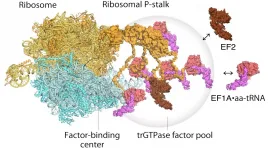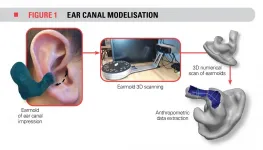(Press-News.org) Since 2006, a fungal disease called white-nose syndrome has caused sharp declines in bat populations across the eastern United States. The fungus that causes the disease, Pseudogymnoascus destructans, thrives in subterranean habitats where bats hibernate over the winter months.
Bats roosting in the warmest sites have been hit particularly hard, since more fungus grows on their skin, and they are more likely to die from white-nose syndrome, according to a new study by researchers at Virginia Tech.
But instead of avoiding these warm and deadly sites, bats continue to use them year after year. The reason? Bats are mistakenly preferring sites where fungal growth is high and therefore their survival is low. This is one of the first clear examples of an infectious disease creating an "ecological trap" for wildlife.
Kate Langwig and Joseph Hoyt, both assistant professors from the Department of Biological Sciences in the College of Science, have been studying little brown bat (Myotis lucifugus) populations in Michigan and Wisconsin since 2012, before the fungus first reached those states. This long-term study was the perfect opportunity to see if bats alter their preferences across hibernacula, or hibernation sites, in response to the invasion of white-nose syndrome.
"We see that there is a shift across the regional bat population over time," said Skylar Hopkins, a previous postdoctoral scholar at Virginia Tech and now assistant professor at North Carolina State University.
"When we look at the population post-invasion, we see that more than 50 percent of the bats are still choosing to roost in warmer sites, even though colder sites are available. But on average, bat roosting temperatures have declined, because the colder-roosting bats have had higher survival rates."
Their findings were posted in Nature Communications.
To understand how temperatures are playing a role in bat population declines, the researchers used a mark-recapture method, which involves banding bats and then trying to find them later.
The team visited bat hibernacula for sampling twice per year: once in early hibernation, after all of the bats had arrived and settled down for the winter, and once again in late hibernation, before the bats emerged from their hibernation habitat.
If bats were missing in late hibernation that had been present earlier in the winter, those bats had left the hibernacula early and likely died in the cold, insect-free Midwest winter.
The research team also used a swab to measure the fungal loads that were on each individual bat and used a laser thermometer to measure the roosting temperature of the rocks next to each bat.
Now that they know that bats are preferring high mortality sites, Hopkins hopes that their data can be used to think about which sites researchers and conservationists need to prioritize for conservation and how to conserve them.
"Because we know that bats are doing better in the cold sites, the cold sites may be good ones for us to conserve," said Hopkins. "We can also think more about the warm sites that are acting as ecological traps and whether we should be trying to manage those sites in a different way. Maybe there are interventions that should be done at those sites to prevent most of the population from going there each year and having these big mortality events."
One's first instinct upon hearing about these interventions would be to close off these deadly hibernacula entirely. But according to Langwig, it's just not that simple.
"The thing that is hard is that there are multiple bat species in these habitats. And I worry that there would be cascading impacts on some of the other bat species if we attempted to alter the sites. It depends a lot on the physiology of the bat," said Langwig, who is an affiliated faculty member of the Fralin Life Sciences Institute and the Global Change Center. "But there may be some creative solutions. There are researchers in Michigan and Pennsylvania who have been working to cool down the warmer sites by modifying the entrances or using solar power to pump air into the sites."
Of course, temperature is just one aspect of the microclimate that bats experience while they are hibernating. Hopkins and Langwig expect that humidity could also play a role in the spread of white-nose syndrome. But, measuring humidity is easier said than done. Since underground hibernacula have a high relative humidity, it can be difficult to make accurate measurements.
"We've designed new humidity loggers to collect better humidity data than has been possible before. These loggers are already deployed in caves and mines across the eastern United States, so we hope to soon understand how humidity has played a role in bat population declines, if at all," said Hopkins.
INFORMATION:
- Written by Kendall Daniels
An invisible flow of groundwater seeps into the ocean along coastlines all over the world. Scientists have tended to disregard its contributions to ocean chemistry, focusing on the far greater volumes of water and dissolved material entering the sea from rivers and streams, but a new study finds groundwater discharge plays a more significant role than had been thought.
The new findings, published January 8 in Nature Communications, have implications for global models of biogeochemical cycles and for the interpretation of isotope records of Earth's climate history.
"It's really hard to characterize groundwater discharge, so it has been a source of uncertainty in the modeling of global cycles," said first author Kimberley Mayfield, who led the study as ...
Pleiotropy analysis, which provides insight on how individual genes result in multiple characteristics, has become increasingly valuable as medicine continues to lean into mining genetics to inform disease treatments. Privacy stipulations, though, make it difficult to perform comprehensive pleiotropy analysis because individual patient data often can't be easily and regularly shared between sites. However, a statistical method called Sum-Share, developed at Penn Medicine, can pull summary information from many different sites to generate significant insights. In a test of the method, published in Nature Communications, Sum-Share's developers were able to detect more than 1,700 DNA-level variations that ...
A joint group of scientists from Finland, Russia, China and the USA have demonstrated that temperature difference can be used to entangle pairs of electrons in superconducting structures. The experimental discovery, published in Nature Communications, promises powerful applications in quantum devices, bringing us one step closer towards applications of the second quantum revolution.
The team, led by Professor Pertti Hakonen from Aalto University, has shown that the thermoelectric effect provides a new method for producing entangled electrons in a new device. "Quantum entanglement is the cornerstone of the novel quantum technologies. This concept, however, has puzzled many physicists over the years, including Albert Einstein who worried a lot about the ...
Reactive molecules, such as free radicals, can be produced in the body after exposure to certain environments or substances and go on to cause cell damage. Antioxidants can minimize this damage by interacting with the radicals before they affect cells.
Led by Enrique Gomez, professor of chemical engineering and materials science and engineering, Penn State researchers have applied this concept to prevent imaging damage to conducting polymers that comprise soft electronic devices, such as organic solar cells, organic transistors, bioelectronic devices and flexible electronics. The researchers ...
Jan. 8, 2021 - A new study published online in the Annals of the American Thoracic Society examines the recovery of lung function and overall wellness in individuals who had varying degrees of COVID-19 severity. Little is known about lung health following infection with SARS-CoV-2, the virus that causes COVID-19, and whether later respiratory problems, fatigue and ill health are associated with the disease's initial severity.
In " END ...
Researchers from Oklahoma State University, University of Missouri, Iowa State University, and University of Georgia published a new paper in the Journal of Marketing that investigates the question of how salespeople should balance advocacy for the seller with advocacy for the customer.
The study, forthcoming in the Journal of Marketing, is titled "Salesperson Dual Agency in Price Negotiations" and is authored by Justin Lawrence, Lisa Scheer, Andrew Crecelius, and Son Lam.
How should salespeople represent both the seller and the customer when their interests diverge, as in pricing negotiations? The research team extends a dual agency framework to the sales domain and examines the salesperson's role throughout the three stages of the discount process: (a) the ...
Ribosomes are the complexes of ribonucleoproteins at the heart of protein synthesis in cells. However in the absence of conclusive evidence, how these complexes operate has been open to debate. Now Hirotatsu Imai and Noriyuki Kodera at Kanazawa University, alongside Toshio Uchiumi at Niigata University in Japan, show visualizations of the structural dynamics and factor pooling that take place at ribosome stalk proteins as they build new proteins.
Ribosomes were first discovered in the 1950s and their broad function has been widely understood for some time - they read messenger RNA sequences and from that generate sequences of correctly ordered amino acids into new proteins. The ribosome stalk protein in particular plays an ...
Noise exposure accounts for 22% of worldwide work-related health problems. Excessive noise not only causes hearing loss and tinnitus, but also increases the risk of cardiovascular diseases. To provide protection, workers normally wear earplugs. However, commonly available earplugs are often uncomfortable, since they don't fit everyone's ears equally well.
How could we improve the comfort and effectiveness of these earplugs? What aspects of the ear canal must be taken into account? To answer these questions, researchers from the École de technologie supérieure (ÉTS University) and the Institut de recherche en santé et sécurité ...
Non-violent offenders serving time for drug use or possession should be freed immediately and their convictions erased, according to research published in the peer-reviewed The American Journal of Bioethics.
More than 60 international experts including bioethicists, psychologists and drug experts have joined forces to call for an end to the war on drugs which they argue feeds racism.
All drugs currently deemed illicit - even crack cocaine and heroin - should be decriminalized as a matter of urgency, according to this new alliance. Legalisation and regulation should then follow with restrictions on age, advertising and licensing, they say.
They have analysed evidence from over 150 studies and reports, concluding that prohibition unfairly affects Black people, damages communities, ...
A new study has found that spending time outdoors and switching off our devices is associated with higher levels of happiness during a period of COVID-19 restrictions.
Previous academic studies have indicated how being outdoors, particularly in green spaces, can improve mental health by promoting more positive body image, and lowering levels of depression and anxiety.
Jointly led by academics from Anglia Ruskin University (ARU) in the UK, the Karl Landsteiner University of Health Sciences in Austria, and Perdana University in Malaysia, this new research examined how levels ...






